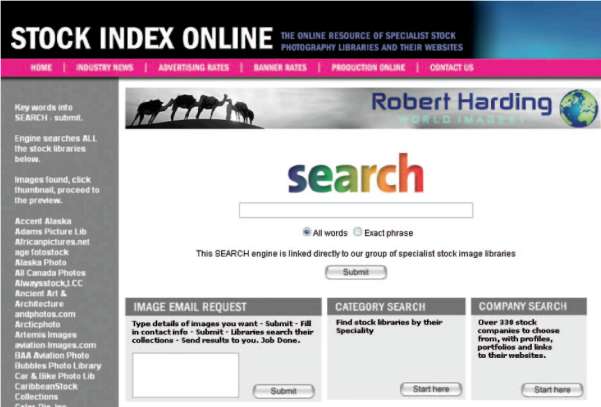CHAPTER 9
Mixing It with Rights-Managed Stock
Once you have got your feet wet in the world of microstock photography, you may start casting around for other ways to make money from your photography. After all, your confidence will have grown from some success in the world of microstock, so it is reasonable to look at the alternatives.
I know quite a few microstock photographers who have expressed an interest in the more traditional stock outlets. It can be rewarding to sell an image for $100, $500, or even more instead of just $1 or $2. That is not to say that you will earn more per image over time with a traditional rights-managed or royalty-free library (you may or may not), so beware of confused thinking that leads to disappointment.
There are many “traditional” image libraries serving a wide range of markets. You may know of the big guns like Getty or Corbis, but there are hundreds of others. However, there are some rules to observe.
First, you cannot sell your microstock images as licensed or rights-managed images through traditional outlets. Buyers of rights-managed images would be appalled to find an image they had purchased on a single-use basis being used royalty free by others. You would also probably be breaking the library's rules.
Second, you may not be infringing any rules by selling your microstock images royalty free through a traditional royalty-free channel, but the pricing is so different that it is bad practice to do so. In other words, you should develop a separate portfolio for sale through traditional outlets, as I have done (Figure 9.1).
The most popular general “open” library seems to be Alamy, based in Abingdon, near Oxford, England. “Open” means that Alamy does not select images by reference to subject matter, composition, and so on, but only by reference to technical standards and legal compliance. Alamy leaves the photographer in charge, for better or for worse, and it seems to be a successful formula given the rapid growth that Alamy

FIGURE 9.1 “Egyptian Farmers.” Images like this are good potential travel editorial work for sites like Alamy. © Quentin Bargate
has enjoyed over the past few years. Most of Alamy's sales are for editorial use, illustrating news articles, travel books, and the like, not for advertising.
If you are selling images through Alamy rights managed, then you have greater freedom to include copyright works and logos incidentally in your photographs. You may also include recognizable faces. However, you will then be restricted to selling such work for editorial use only.
Alamy has approximately 10 million images for sale at present, which makes it several times larger than the largest microstock, Fotolia, which has about 2.2 million images. Recently, Alamy has borrowed some of the microstocks' clothes by imposing a zero-tolerance image-inspection regimen, image upload (but still not FTP), and a user forum. That should make Alamy a very comfortable choice for microstock photographers looking to break into the world of the traditional libraries.
SPECIALIZED LIBRARIES
Aside from big open libraries like Alamy, there are many specialized smaller libraries servicing distinct market sectors. There are portals that provide information about and links to many small specialized libraries. One I know well is Stock Index Online (Figure 9.2), which can be found at http://www.stockindexonline.com.
Pretty much every specialty has a library that caters to it. For example, if you have some excellent wildlife images, you might decide to send them to a specialized wildlife library such as Ardea at http://www.ardea.com/, a specialized rights-managed library, or one of a number of other choices.
By placing your more specialized images with a library that targets the right market, you might see better sales than if you only place your nonmicrostock work with a general library such as Alamy. Of course, you will not normally have to choose one or the other. Unless otherwise stipulated in the terms and conditions, you will be able to place your nonmicrostock work with both a general library and a specialized outlet.

FIGURE 9.2 Stock Index Online is a useful resource for both photographers looking for specialized library outlets and photo buyers searching for images.
SOME USEFUL SPECIALIZED LIBRARY PORTAL LINKS FOR PHOTOGRAPHERS AND BUYERS
Below, I list a few useful links to specialized library portals:
- Stock Index Online. An online portal with some 330 member libraries. Image search facility, library details, and more are available. http://www.stockindexonline.com.
- PhotoSource International. A meeting place for photo buyers and suppliers. http://www.photosource.com/
- Fotosearch. Stock photography and stock footage; useful sidebar links. http://www.fotosearch.co.uk/
CULTURAL DIFFERENCES
There are some cultural differences between the microstock libraries and traditional outlets. To start with, sites like Alamy require images of a certain minimum uncompressed size. In Alamy's case, it is 48 MB. Most traditional outlets require images around the 50-MB mark. Unlike the microstock libraries, you not only can but must interpolate smaller files to this minimum size or the image will be rejected. This, in turn, means you really need to use a decent dSLR or high-quality rangefinder like the Leica M8 to meet the demands imposed by interpolation, or, better still, a camera that outputs files that are 50 MB or more. But that involves spending more money and acquiring professional-level equipment. Images from a decent 6-MP camera can, with care, successfully be interpolated to 50 MB, and Alamy will accept them but some libraries might not. Standards are rising all the time.
A few of the top libraries have an approved list of cameras you must use. Of course, if you shoot film, there will be no Camera EXIF data embedded in the scan to give away the type of camera used; so, ironically, for this reason plus the fact that film grain is often less of an issue with the traditional libraries, film can be a good choice for them if well scanned and prepared.
Also be aware that the small specialized libraries do not normally offer FTP or any other form of image-upload facility. Instead, you need to burn your images to a DVD and post your work to them.
Finally, if you are really sold on the whole “Whoo! Yay!” culture of some of the microstocks, you may find the smaller libraries a little more serious. They look to develop a close working relationship with a small number of photographers. You might find it a refreshing counterbalance to your burgeoning microstock portfolio.
If you are a buyer looking for specific images, then you could try using a search portal like http://www.fotosearch.com/, which allows you to search many libraries simultaneously.
WHAT TO DO
Obviously this book is directed mainly at the exciting new world of microstock photography, but my advice is to keep an open mind. I send work to traditional libraries as well as to the microstocks. It's a bit like choosing whether to invest in gilts or stocks and shares. Both offer the possibility of financial return, but both have different strengths and weaknesses. My philosophy is to send more personal work—in my case, large-format landscapes, for example—to the traditional libraries. It can be a good idea to hang out at the independent forums to learn what others are up to and to share recent experiences in what is a fast-moving and changing market.
Check Appendix 3 for a list of stock libraries you might want to consider.
